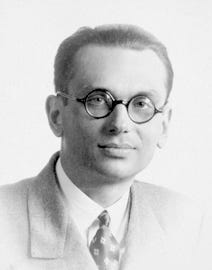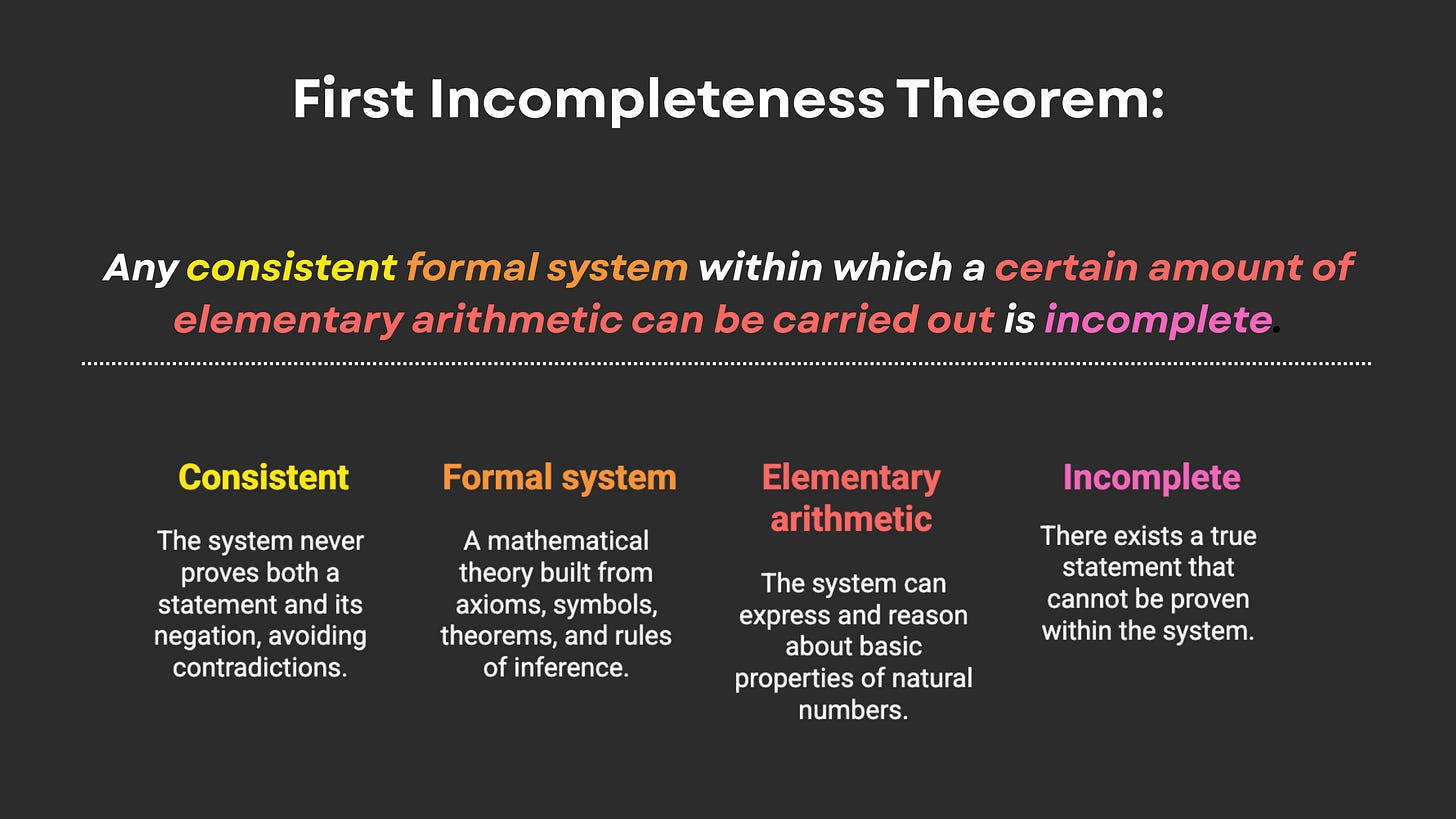This is my attempt to explain Gödel’s Incompleteness Theorems in a way that actually makes sense.
If you’ve ever:
Come across Gödel’s theorems but didn’t fully get them,
Or heard people say that math is “broken” or “paradoxical” and want to finally understand why, even without a math background,
Then this post is for you. And if you get stuck at any part, please leave me a comment so I can explain better.
We’ll start with the “why,” then build up to what the theorems actually say, and then we’ll go deeper and actually walk through the outline of Gödel’s proof.
First - A Mini Exercise
Think about this sentence:
“This sentence cannot be proven.”
If it could be proven, then it would be false, because it says it can’t be proven. But if it can’t be proven, then it’s actually true.
This kind of self-referential trap is going to be very important later. And it’s exactly the intuition behind the paradoxes Gödel showed is built deep into math.

Then - Some Story
In the early 1900s, mathematicians were trying to build a perfect foundation for math - something clean, completely describing math, and contradiction-free. One of the most famous mathematicians, David Hilbert, believed this was absolutely possible. He even laid out a research program called Hilbert's Program to formalize math and find this perfect system.

But then in 1931, Gödel (just 25 years old) published a short paper that completely destroyed Hilbert’s dream.
Gödel said that we can never find a complete and consistent foundation for all of math. And he proved it.
So… what did Gödel prove exactly?
First Meeting With The Theorems.
There are two Gödel's Incompleteness Theorems, even though the first one is the more famous one. The first one says:
First Incompleteness Theorem: Any consistent formal system within which a certain amount of elementary arithmetic can be carried out is incomplete.
Here, I made a quick explanation of its every part, but we get to this later in more detail:
The second theorem says something that follows up from the first theorem and is also a bit spooky:
Second Incompleteness Theorem: A formal system like that (described in the first theorem) can’t prove its own consistency.
Intuitively, the second theorem says you can't even prove from within math that math itself is trustworthy.
My Note About Why I’m Explaining The Theorems
Note that there are many formulations of the theorems, some are more vague and less rigid. For example, an equivalent statement of the first theorem is “Every mathematical system will have some statements that can never be proved.”
But that’s one tricky fact about Godel’s theorems. I think they are getting huge popularity, partially because they sound normal and not dangerous. They don’t use any weird symbols and equations, like many math theorems that you see and immediately think “No thanks, I won’t even try to read that”… Such as the mean value theorem:
Godel’s theorems at first glance look like you might understand them, because they contain words like “powerful” or “system” or “consistency” or “provability,” which you have some intuition for already, from normal life. But all these terms have their rigorous definitions in math, and we need to understand them even more because they look so “normal”. From my experience, the normal-sounding math can be the most tricky one because your brain tells you that it’s already familiar, and you don’t realize you don’t actually understand.
So let me explain the theorems in detail, and only after we focus on understanding what the theorems really say, can we move to the next part: proving them & enjoying it!
Explaining Every Piece of The Theorems
Now, back to my visual:
💛 Consistent
A set of axioms is consistent if there is no statement such that both the statement and its negation can be proven from those axioms.
In other words, the system doesn’t contradict itself.
We obviously need to require consistency in the theorem. Because if the system were inconsistent, then you could prove literally anything, even false things, which makes the whole system useless. That’s why Gödel’s theorems only apply to consistent systems.
🧡 Formal system
A formal system is something very central to math, and you probably already know what it is, maybe without realizing. A formal system is just a mathematical theory - that is, a framework, or we could say “structured setup” consisting of:
Axioms - basic rules or statements that we accept as true without needing to prove them.
For example: “0 is a number.”Symbols - a notation to write down statements.
For example:0for zero,+,×,=for addition, multiplication, and equality,∃for “there exists”,∀for “for all”,→for “implies”, and¬for “not”.Theorems & rules of inference - statements & rules for how to make new true statements from old ones.
These are things like:If
PandP → Qboth are true, thenQis true.Induction: If a statement is true for
0, and if the statement being true forximplies it’s true forx + 1 -Then it’s true for all natural numbers.
You start with axioms, use symbols to write statements, and apply rules of inference to build more and more complex theorems — ideally, all of mathematics. I’m always saying that we build math like LEGO.
Sometimes we call a “formal system” a theory, and the statements we prove inside it - using those axioms and rules - are theorems.
This is the core of how math works, in my opinion. Super important.
❤️ “A certain amount of elementary arithmetic can be carried out”
This is the part that often confuses people, but it’s actually quite simple.
Gödel just means that the system is powerful enough to express the basic facts of arithmetic. In other words, it must be able to write down and reason about simple number-based statements using its axioms and rules of inference.
So the system should be able to say things like:
x + 0 = xx × 1 = x“For every number, there is a next number”
“There exists a number y such that x = y × y”
Just this much arithmetic is enough for Gödel’s theorems to apply to all math. (In the next section, we explain why).
🩷 Incomplete
Incomplete means that there exists a statement in the language of the system that is not provable — it can be neither proved nor disproved from the axioms of the system.
This is the conclusion of the theorem. We first describe what system we talk about (needs to be consistent, and the other conditions), and the,n as the conclusion, we state that such systems are always incomplete.
So intuitively, there is always a statement in mathematical formal systems that is out of logical reach.
Example of Formal System: Peano Arithmetic
A lot of versions of Gödel’s theorems’ proofs use Peano Arithmetic as an example of a formal system that follows the conditions of the theorem. So I say a few words about Peano Arithmetic (PA). You already know it, though - from elementary school.
I said every formal system has axioms, symbols, theorems, and rules of inference. For Peano, it’s these:
1. Axioms of Peano Arithmetic
Zero is a natural number. (Some formulations use 1 instead of 0 as the "first" natural number)
Every natural number x has a successor s(x) in the natural numbers.
Zero is not the successor of any natural number.
If the successor of two natural numbers is the same, then the two original numbers are the same.
If a set contains zero and the successor of every number is in the set, then the set contains the natural numbers.
These are basically just saying that there are numbers like 0, 1, 2, 3, 4, 5, … there is always the next one, it starts with 0, and the numbers are unique.
2. Symbols of Peano Arithmetic
Symbols are basically the 0, 1, 2, 3, …, the +, -, and other signs, and some formulations, for example, denote the successor of a number x by S(x).
3. Rules of inference and statements (theorems)
Let’s say we have a theorem
0 + x = x for all natural numbers x.
This feels intuitively true and totally obvious, but in a formal system like PA, we need to prove it using only the allowed axioms and inference rules. We’ll use a proof technique called mathematical induction, and we try to prove this theorem, just so you get a sense of how a formal system is built.
1. Base Case (x = 0):
We check the statement for x = 0:
0 + 0 = 0
This is one of the axioms of Peano Arithmetic, so it’s an obvious truth we can use to start with. So the base case is automatically proven.
2. Inductive Step:
Now we assume that the statement holds for some arbitrary number x. This is called the inductive hypothesis:
0 + x = x
Now we want to prove that if it holds for an arbitrary number x, it also holds for the next number, s(x) (the successor of x):
0 + s(x) = s(x)
Using the recursive definition of addition from PA:
0 + s(x) = s(0 + x)
(This is just how we decided to define addition in PA)
But from the inductive hypothesis, we know:
0 + x = x
And if we apply the successor, it follows that:
s(0 + x) = s(x)
And therefore:
0 + s(x) = s(x)
This completes the inductive step.
Conclusion of the proof:
By the principle of mathematical induction, we have shown that “if the thing is true for x, it’s true for x + 1 every time”, which applies it to all natural numbers, and hence:
For all natural numbers x, 0 + x = x
This is now an example of a theorem in the Peano Arithmetic system. And we’ve proven using only axioms and inference rules.
This is basically the core of math. We always start with axioms in any mathematical theory and derive the rest, using different logical techniques.
Summary Of What We Learned
Let’s get back to the theorems once again:
First Incompleteness Theorem: Any consistent formal system within which a certain amount of elementary arithmetic can be carried out is incomplete.
Consistent:
The system never proves both a statement and its negation. In other words, it doesn't contradict itself.
Formal system:
A mathematical theory built from:Axioms - basic obvious assumptions we take as true (like “0 is a number”),
Symbols - notations like
0,+,=,Theorems & rules of inference - statements & rules of how we derive new statements from old ones.
Elementary arithmetic can be carried out:
The system can express and reason about basic properties of natural numbers, like addition, multiplication, and induction. The system can define numbers and talk about its own logicIncomplete:
There exists a statement in the system’s language that is true, but cannot be proven using the system’s own axioms and inference rules.
It’s not false. It’s not provable. It’s undecidable within the system.
Second Incompleteness Theorem: No formal system (like the one described in the first theorem) can’t prove its own consistency.
Ready For Part Two?
For the first blog post, it’s enough to understand what the theorems are really saying, and get used to it. In the second blog post, we sketch the proof of the first theorem. And we will clarify more questions you might now have. Such that
If math is so huge, how can Gödel’s theorems talk just about formal systems that express elementary arithmetic?
How is some simple arithmetic enough to prove big truths about all mathematical systems?
How do we use math to prove the theorems… if they are actually talking about math? Won’t we be going in circles?
Stay tuned for the second part, and please leave me a comment! :)









Clear and helpful writing. You did a great job breaking it down <3